Contents
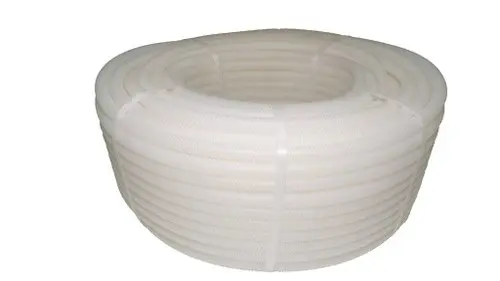

Ants on currants are a potential danger. Insects are tenacious, very prolific, they feed on berries and plant nectar. Particular harm is due to the fact that ants help the spread of aphids. Therefore, it is necessary to start destroying them immediately. To do this, use different methods, including traps, baits, folk methods and chemicals.
Causes of appearance
In the bushes of currants and other plants, different types of ants settle:
- red forest;
- brown meadow;
- black garden.
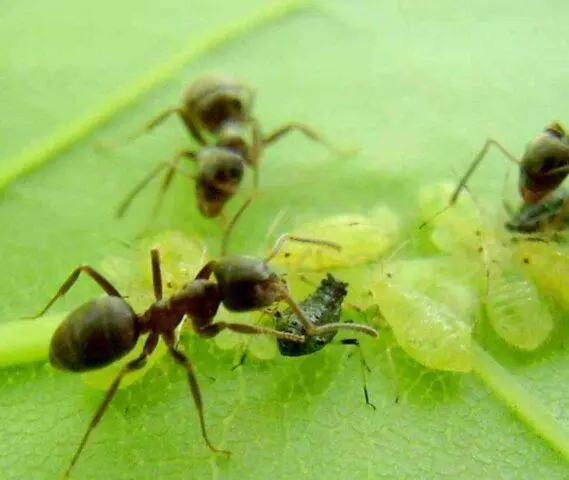
Insects are ubiquitous on all continents, including in the temperate zone.
The following factors can provoke their appearance:
- thickened currant plantings;
- lack or lack of loosening and weeding;
- late collection of fallen leaves, branches;
- lack of preventive treatments for aphids, which contributes to the life of ants.
Consequences of an ant attack
The main danger of insects for currants is that they feed on honeydew, a sweetish mucus that is secreted by aphids. In “gratitude” ants “herd” the pest, protecting it from other predators, such as ladybugs. These two species of insects live in close symbiosis (mutually beneficial cooperation).
As for aphids, its harm to currants is obvious:
- feeds on cell sap and weakens plants;
- injects toxic substances into tissues;
- causes deformation and death of sheets;
- shoots stop developing;
- the tops are deformed;
- reduces the yield of currants;
- parasitism has a bad effect on the immunity of the shrub to other diseases and pests.
At the same time, it cannot be argued that ants are completely harmless to currants. Even without symbiosis with aphids, they pose a certain danger to black, red or white currants:
- Spreading weed seeds.
- Currant buds and petals are damaged, trying to get to the nectar.
- Can spoil newly emerged seedlings.
- If there is little food, sweet fruits, including currant berries, also begin to be damaged.
- They produce a large number of waste products, including formic acid, which increases the acidity of the soil, which over the years has a bad effect on the growth of bushes and the taste of fruits.
Both pests must be dealt with immediately, otherwise the yield will decrease significantly.
Benefits of Ants
Ants not only harm the currant, but also give it and other plants a certain benefit:
- loosen the surface layer of the soil, improving the access of oxygen and moisture to the roots;
- destroy insect larvae, mites, caterpillars;
- resist slugs.
Ants make passages in the soil, which can reach a depth of 1-1,5 m, this leads to an improvement in fertility. The proportion of phosphorus compounds increases 10 times, potassium – 2-3 times. Pests are very persistent and prolific, they can multiply in large numbers, and then they will do much more harm than good.
Ants must be removed from under the currant, as they do more harm than good. This is especially important if the invasion is too large, and aphid has appeared along with the main pest. On the other hand, it is not worth completely destroying the population, since it is an integral element of biological balance. It is enough to carry out 1-2 treatments with folk remedies or simply put traps on the site.
How to save currants from ants in spring
There are many ways to deal with ants on a currant. For this, it is not necessary to immediately use chemicals. Usually they are used in the case of very large invasions, when other methods have not given the desired results. It is advisable to start with folk remedies, mechanical methods, including improvised means.
Pungent odors
Ants that live on currants and other plants do not tolerate strong odors. Therefore, in the fight against them, you can use the following means:
- food vinegar 9% (you do not need to use a strong essence, it is only suitable for ruining an anthill);
- ammonia;
- laundry, tar soap (shavings or liquid);
- fragrant plants: chamomile, parsley, anise, cumin, bay leaf, mint (they can be planted or dried raw materials can be used);
- hot pepper – seasoning or chopped pods;
- fresh garlic – chopped cloves, arrows;
- essential oils: citrus, coniferous, lavender, cinnamon, cloves.
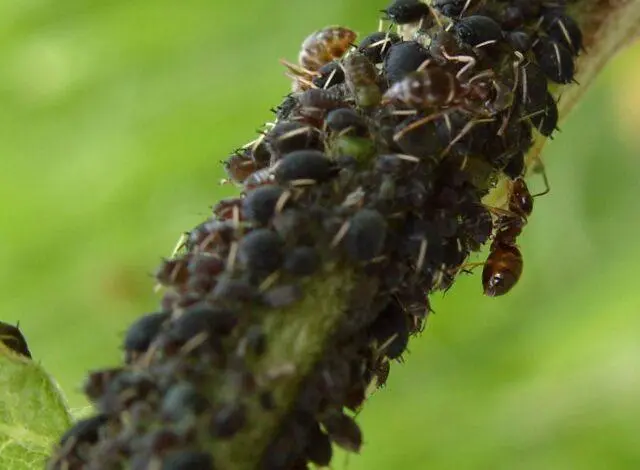
Insects are afraid of pungent odors of essential oils, citrus fruits and fragrant herbs.
Fragrances can be used in a variety of ways. Cotton balls are impregnated with oils and solutions and laid out around currants, along paths where pests are seen and along the perimeter of other plantings. Solid mixtures, such as garlic or chili peppers, are also scattered there. As for fragrant plants, they can simply be planted around the perimeter of the site and provide minimal care.
Folk methods
You can also get rid of ants on currants with folk remedies. The most effective recipes are:
- Soda is mixed with edible sugar in equal amounts. Dilute with a small amount of water. Stir until complete dissolution. Water all paths with this solution, and also pass along the perimeter of currant plantings.
- To scare away ants, at the base of the bush, you can make a “ring” of linseed oil and soot – coat the trunk to a height of 10 cm.
- Spray the places of accumulation with a warm infusion of fragrant flowers and herbs – onions (husks and root crops), tansy, celandine, mint, marigolds, tomato tops, mustard.
- Another way to deal with ants is to spread pieces of fresh onions, peels of oranges, lemons or other citrus fruits along the paths.
- To fight ants, you can take natural sheepskin or other wool, cut into narrow strips, moisten them in a solution of carbolic acid and wrap the trunk of a bush.
chemical
You can get rid of ants on a currant bush with the help of chemicals. Insecticides are used for prevention, as well as for control in advanced cases, when the invasion is too strong and folk remedies do not help. The most popular drugs for these insects:
- “Muracid”;
- “Zareed Spider”;
- « Claus»;
- “Ant” and others.
Mechanical methods
Along with the treatment of currants from ants, mechanical methods of prevention are also used. Insects can settle right on the site or near it by building an anthill. Such places of accumulation must be destroyed, because pests are prolific and will eventually multiply to catastrophic proportions.
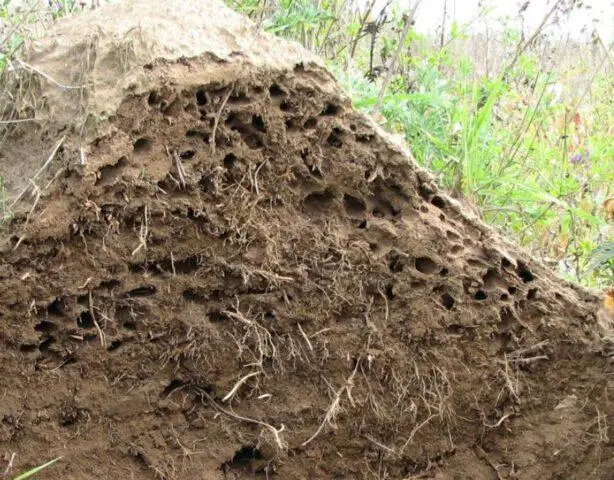
Anthills in or near the garden should be removed
You can ruin the dwelling of ants in order to save currants in the following ways:
- break up with a shovel;
- pour boiling water;
- pour any liquid oil;
- treat with acetic acid (essence 70%).
If you don’t want to ruin the anthill, you can simply move it by digging the earth around the circumference to a depth of 20-30 cm. Then put the “dwelling” in a bucket and take it away to a field or forest.
Traps, baits and barriers
Other mechanical methods are used to control pests on currants:
- Traps against ants – strong poison and bait are poured into them. The method is effective due to the fact that the insect brings poisonous substances into the anthill that cling to the paws. Traps can be purchased at an affordable price.
- To fight ants on currants, you can take a small handful of yeast and pour them with a strong solution of sugar, honey and water (1: 1: 1). The thick mixture is laid out in matchboxes, left open and placed next to the currant bushes.
- Also, to prevent the invasion of ants on currants, you can wrap a piece of foil around the trunk, making it look like a skirt – the top edge fits snugly, and the bottom one diverges at an angle. A small piece of foam rubber is placed under it to maintain shape. Instead, you can use the cut off neck of a plastic bottle.
- Another option for an ant barrier on currants is to take thick paper and wrap it around the trunk in a spiral, wrapping it with masking tape on the inside.
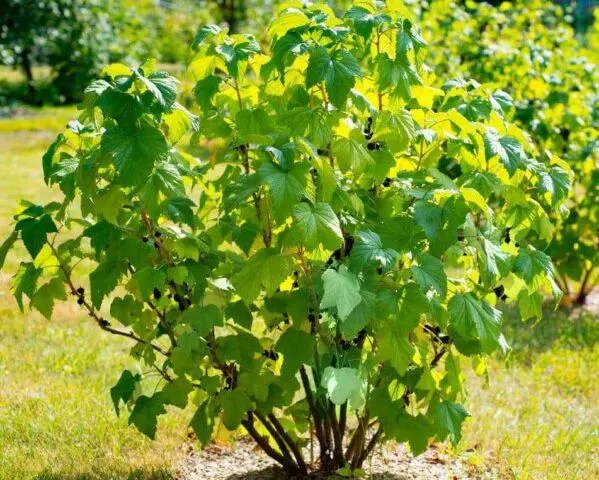
If you protect the bush from ants and other pests, it will be healthy and give a good harvest.
How to protect currants from ants
Invasions of currants can be very strong, and pest control is not always easy. Therefore, it is better to take care of effective preventive measures in advance:
- Dig up the soil in spring and autumn, apply wood ash in the amount of 150-200 g per 1 m2.
- Periodically carry out weeding and loosening.
- Do not plant currant bushes too close to each other.
- To prevent the appearance of ants on currants, you need to remove all garbage from the site, preventing its accumulation.
- Plant at least a little calendula on the site – it attracts ladybugs that destroy aphids, which will also have a bad effect on the ant colony.
- It is necessary to try to protect currants from ants in early spring. To do this, the bushes are treated with insecticides or folk remedies in late May – early April.
- Periodically inspect currant plantings and prevent the spread of aphids and other pests.
Conclusion
Ants on currants are dangerous both in themselves and due to the fact that they contribute to the invasion of aphids. Both pests are very prolific. They cause significant damage, their appearance leads to a decrease in yield. Therefore, it is necessary to deal with insects at the first sign of appearance. If anthills are found near the site, they must be destroyed or taken to the forest.









